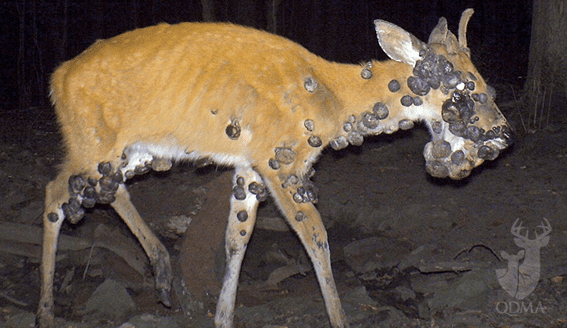LAST UPDATED: March 25th, 2019
When I checked my trail cameras last summer and found a photo of a doe with a mass of tumors on its front shoulder, I freaked out a little. Crazy thoughts went through my mind. Were the tumors cancerous? Was the population being infested by some weird disease? Was it life threatening? Was it contagious? I had visions of massive die-offs, but really there was no need to worry. The tumors were just cutaneous fibroma, generically known as deer warts.
Cutaneous fibromas are caused by a papilloma virus, and almost all species carry at least some form of it. Like humans, an animal can carry the virus yet show no signs or symptoms related to the virus. Other individuals, however, develop papillomas or warts. Most of these warts are rooted in the surface tissue of the skin and rarely penetrate into the meat or muscle of the animal, which means that any deer killed that has these fibromas is still edible.
The only time an animal with cutaneous fibromas wouldn’t be edible would be if the warts developed a secondary bacterial infection which spread throughout the meat. Swollen warts filled with yellow pus are indicators of infection, so be sure to check the animal thoroughly before making a decision to process the meat. Sometimes just the appearance of the deer can be enough of a turn-off, but once it’s skinned, chances are it will look like any other carcass.

Would you eat this deer, or simply shoot it to put it out of it’s misery?
Sometimes the fibromas are only a temporary nuisance, most likely a result of the animal’s immune system being compromised in some way. Once the animal’s immune system recovers, it can successfully fight off the virus and the warts will eventually heal.
Fibromas can appear as single warts, but they also have a tendency to form in clumps. According to the Quality Deer Management Association’s 2011 Whitetail Deer Report, “Biting insects and contaminated vegetation can transmit the virus from one deer to another, and an infected deer can transmit the virus by direct contact with another animal. Fortunately deer can’t spread the virus to farm animals or humans.”
Killing a deer with cutaneous fibromas doesn’t constitute as mercy killing. More often than not, a deer with these fibromas isn’t suffering in any way. That is, unless it has developed a severe case. Do a Google search of “deer warts” and you’ll see just how out of control these tumors can get. Some of the images no doubt evoke sympathy for the animal. In extreme cases, clusters of tumors around their eyes and mouth definitely impact a deer’s quality of life, and in some cases the deer never recovers.

This deer is obviously the exception on severity of deer warts. Photo: QDMA
Cutaneous fibromas are nothing new in the world of whitetails. Michigan biologists began studying these anomalies in whitetails back in the early 1930s, and other state wildlife agencies soon followed suit. An article by J.P. Sundberg and S.W. Nelson in the December 1981 issue of The Canadian Veterinary Journal cites a 1962 New York survey of fibromas in whitetail deer. Sundberg and Nelson write that, “Fibromas occur most frequently in animals under two years of age.” More recent research supports this and actually implies that yearlings that are exposed to the virus at a young age will eventually become immune to it as mature adults.
Sundberg and Nelson’s 1981 article also found a higher prevalence of fibromas among bucks: “The tumor was diagnosed in 2.1% of the males and 0.4% of the females. This may have been caused by differences in possible exposure to a transmissible agent, to abrasions occurring during fighting of males during the rut, or to rubbing of antlers to shed velvet.” But they also note that the percentage difference could simply be a result of more males being sampled during the survey. At that time, antlerless hunting seasons were more restricted and hunters were encouraged, if not legally forced, to target bucks only.
Cutaneous fibromas have been found in whitetails in almost every state and Canadian province for decades. According to Diseases and Parasites of the White-tailed Deer (Tall Timbers Research Station, 1981), researcher R. F. Shope was the first to discover the specific virus in deer. Shope’s experiments involved infecting whitetails with the viral agent. On average, those deer began showing symptoms of the virus within about seven weeks. However, those symptoms typically began to diminish after two months in most cases and eventually the animals made a complete recovery.
Fibromas can appear in a variety of colors, but gray or black are the most common. Warts can range in size from a half inch to eight inches or more in diameter. Rather than hair, the tumors are covered by leathery skin sometimes dried and flaky in appearance. Cutting into a wart would reveal a solid, white colored mass, and would be lodged in the skin only – hence the term cutaneous, which means “relating to or affecting the skin.” Warts can grow on any part of a deer’s body, but the most common areas are the head, neck, and shoulders.
More than anything, cutaneous fibromas are simply skin blemishes that typically go away with time. Shooting a deer with warts is unfortunate, as the warts detract from the aesthetic value of such a beautiful animal, and can cause many hunters to wrongfully discard the meat in fear that the animal was sick. However, other than their grotesque appearance, cutaneous fibromas are nothing to worry about and are a naturally occurring phenomena in whitetails.

 By
By 



